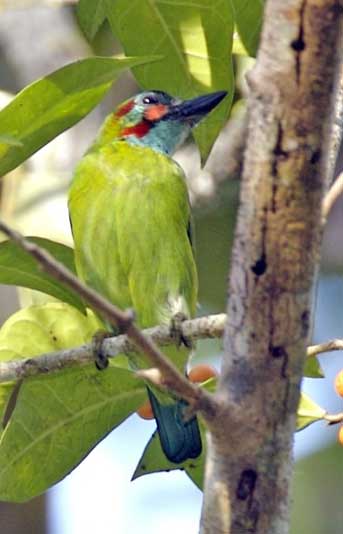Megalaima australis (*) Cladus: Eukaryota Name Megalaima australis (Horsfield, 1821) Reference Transactions of the Linnean Society of London (1) 13 p.181 Vernacular names The Blue-eared Barbet, Megalaima australis, is an Asian barbet. Barbets are a group of near passerine birds with a world-wide tropical distribution. They get their name from the bristles which fringe their heavy bills. Description This small barbet is 17–18 cm in length. It is a plump bird, with a short neck, large head and short tail. The bill is dark, and the body plumage is green, but the subspecies have different head patterns. The adult male of the form, M. a. cyanotis, which occurs from northeast India to peninsular Thailand has a black forehead, blue midcrown, ear coverts and throat, red markings above and below the earcoverts, and orange cheeks. The female has a duller head pattern with a more orange tint to the patches above and below the ear coverts, and the juvenile has a green head with some blue on the ear coverts and throat. The male’s territorial call is a repeated loud ko-tek. Other calls include a whistled pleow. Distribution and habitat The Blue-eared Barbet is a resident breeder in the hills from northeast India east through Southeast Asia to Singapore, Indonesia and Borneo. It is a species of broadleaf evergreen forest, mixed woodland and second growth up to 1525 m altitude. It nests in a tree hole. Subspecies are * M. a. stuarti, western and central Thailand Ripley's M. a. eximia, north Borneo, is now usually split as the Bornean Barbet, M. eximia. References * Birdlife International Source: Wikipedia, Wikispecies: All text is available under the terms of the GNU Free Documentation License |
|

